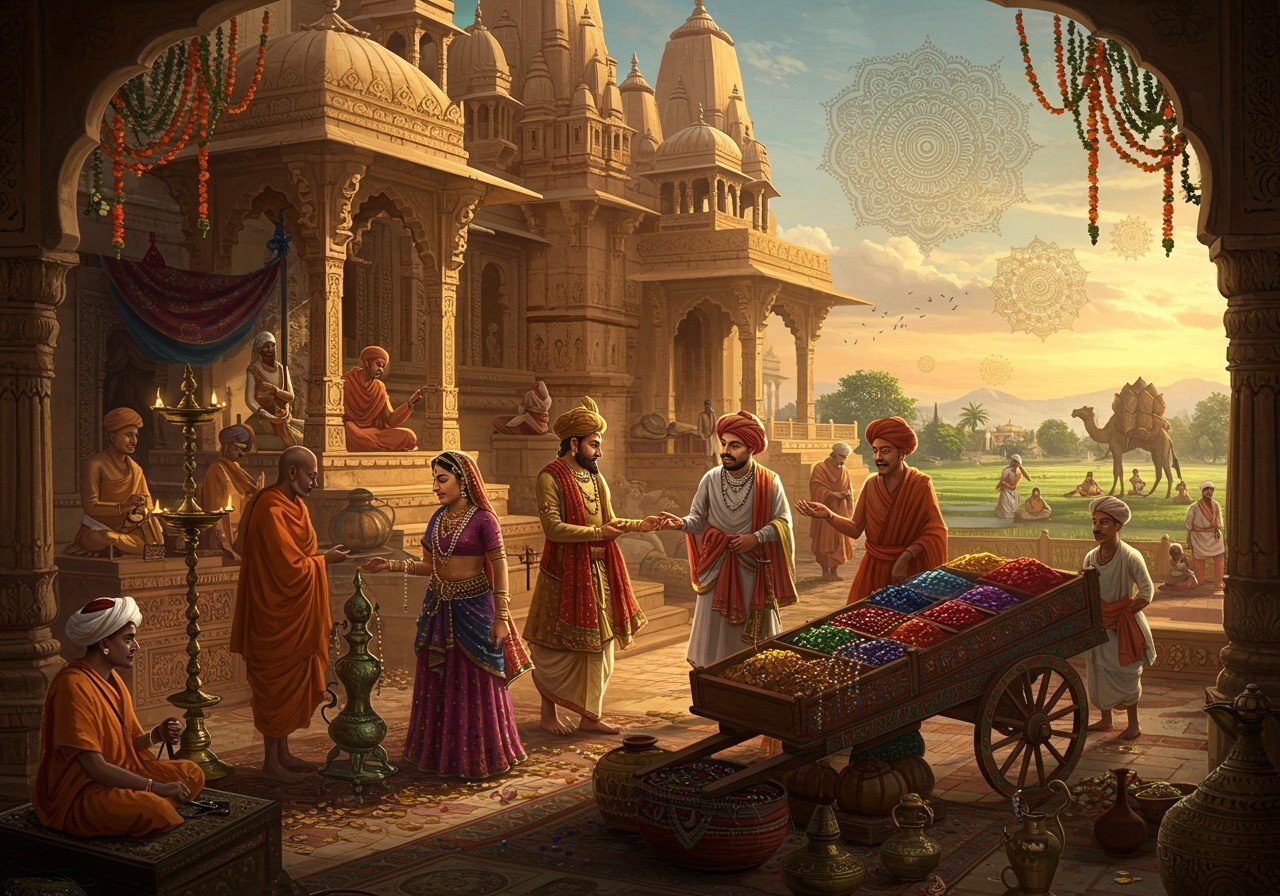
Medieval India, a period spanning from the 6th century after the Gupta Empire’s decline to the Mughal Empire’s rise in 1526, was a time of significant transformations. This era witnessed the rise of the Rajputs, known for their valor and internal conflicts, and saw profound social, cultural, and religious developments. The arrival of the Mughals further altered the landscape of the region.
Society in Medieval India
Medieval India’s social structure was intricate, with the caste system significantly influencing social mobility and daily life. Distinct classes held specific roles and responsibilities. Women’s status varied based on social standing and region, with some making substantial contributions to politics, literature, and the arts. Education, encompassing art, literature, and culture, was highly valued, reflecting societal values. The emergence of regional languages and literature added to the cultural richness of the period. Foreign invasions impacted the social fabric, leading to urbanization and the growth of cities, which, in turn, shaped social structures.
Economy in Medieval India
Agriculture formed the backbone of the Medieval Indian economy. Farmers employed diverse techniques to cultivate crops like rice, wheat, and spices. Trade, both internal and external, played a crucial role, with goods like textiles and precious stones traversing established routes. Guilds ensured quality and standards in craft production. The taxation system impacted economic activities and social classes, while coins and barter facilitated transactions. Rulers’ economic policies also affected the common people.
Religion in Medieval India
Religious diversity characterized Medieval India, with Hinduism, Buddhism, Jainism, Islam, and Sikhism coexisting. Temples, mosques, and other religious structures held significance, and religious leaders propagated teachings and practices. Festivals and rituals fostered community bonds. Religion influenced governance and maintained a strong connection with state institutions. Religious reforms often led to societal changes.
Women in Medieval India
Women’s roles in Medieval India varied depending on their social strata, from royalty to commoners. Educational opportunities differed, with some women excelling in politics, literature, and the arts. Marriage customs and family life were integral to society. While women faced certain restrictions, they also enjoyed some freedoms based on their region and community. Literature and art from this period offer diverse portrayals of women, and religious beliefs influenced their status and roles.
Food in Medieval India
Medieval India boasted rich and diverse culinary traditions, influenced by regional variations. Staple ingredients included rice, wheat, and spices. Cooking methods ranged from roasting and boiling to frying. Food played a central role in religious rituals and festivals. Foreign invasions introduced new ingredients and culinary techniques, enriching the existing culinary landscape. Dining was often communal, with feasts serving as important social occasions.
Clothing in Medieval India
Clothing styles in Medieval India varied across social classes and regions. Materials like cotton and silk were common, with production techniques reflecting regional influences. Climate and geography also impacted clothing choices. Attire served as a marker of social status and identity. Foreign influences introduced new fashion trends, while textiles played a significant role in trade and economic activities. Ornaments and accessories complemented traditional clothing.
Poojn.in, India’s largest cultural goods and services store, offers a wide variety of products relevant to the rich traditions of Medieval India. Here’s how you can connect with the past through Poojn.in:
- Puja Items: Explore a wide selection of traditional puja items like bel malas, tulsi malas, tulsi malas with Radha Krishna pendants, and more, reminiscent of those used in Medieval rituals. These items can enhance your personal spiritual practice and connect you to the rich history of devotion in India.
- Incense and Dhoop: Experience the aromatic traditions of Medieval India with authentic incense sticks and dhoop. These fragrances create a sacred atmosphere and evoke the ambiance of ancient temples and rituals.
- Spiritual Decor: Adorn your home with spiritual décor inspired by Medieval Indian art and architecture. Poojn.in offers a range of Shiva lingams and murtis that reflect the artistic and spiritual sensibilities of the era, bringing a touch of history and devotion to your living space.
Frequently Asked Questions about Medieval India
What defined social hierarchy in Medieval India? The caste system heavily influenced social hierarchy, impacting social mobility and daily life. Different classes had specific roles and responsibilities, shaping the social fabric of the era.
What was the economic foundation of Medieval India? Agriculture served as the economic backbone, with trade (both internal and external) playing a vital role. Goods like spices, textiles, and precious stones were traded along established routes.
How did religion shape Medieval Indian society? Religion played a crucial role in influencing laws, festivals, and daily life. The coexistence of Hinduism, Islam, Buddhism, Jainism, and Sikhism fostered a diverse religious landscape, impacting art, architecture, and literature.
Conclusion
Understanding the various facets of Medieval India—society, economy, religion, the role of women, food, and clothing—provides valuable insights into this transformative period. Studying these aspects allows us to appreciate the era’s richness and its enduring influence on contemporary Indian culture. Explore relevant articles on poojn.in for deeper insights into specific aspects of Medieval Indian culture and spirituality.


